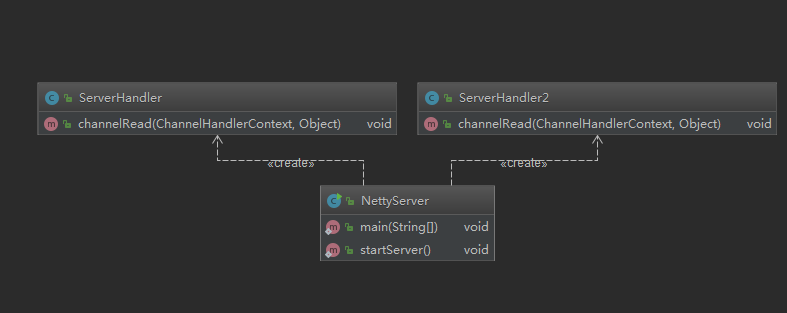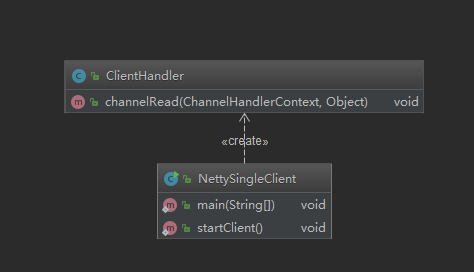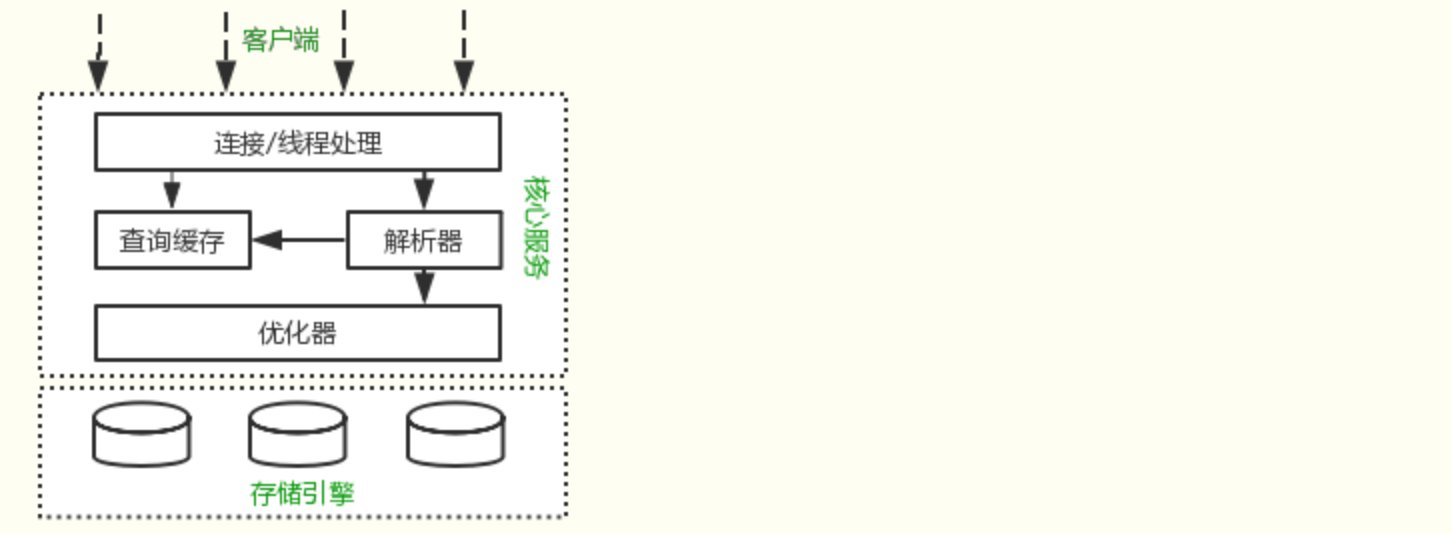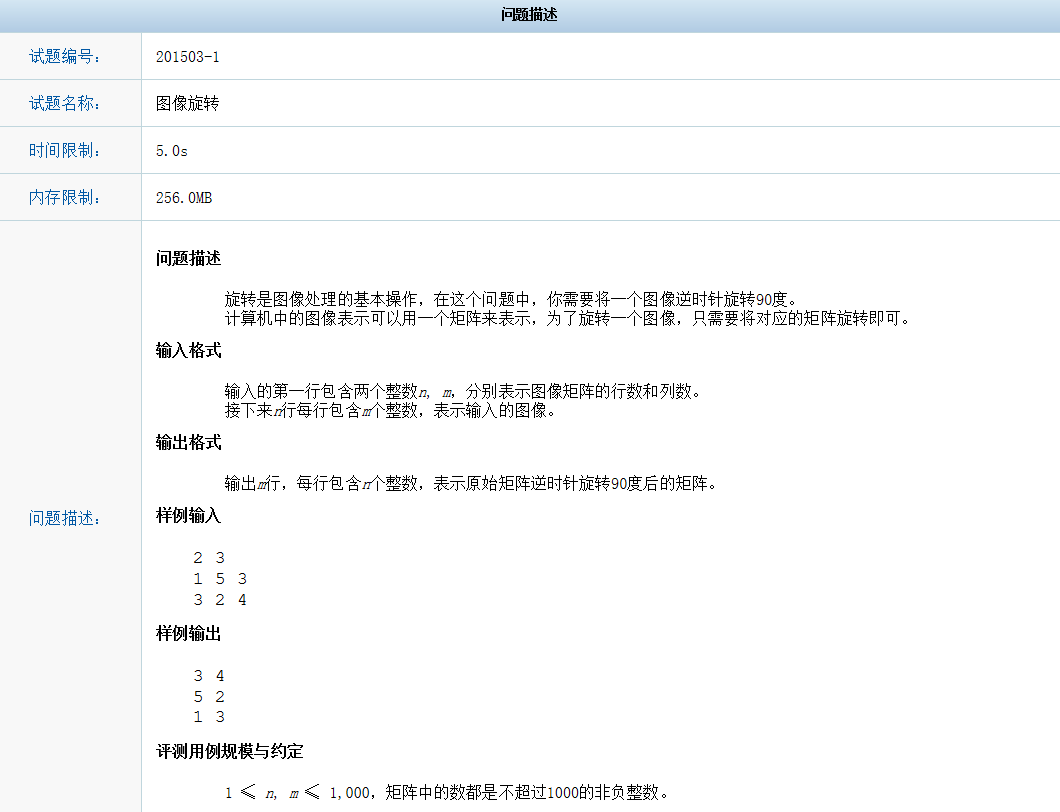Netty4服务端和客户端实现
目录
目标
代码UML类图
服务端
客户端
Netty4实现服务端
Netty4实现客户端
测试
小结
目标
用netty4实现一个服务端和客户端,两者之间可以进行测试通信
代码UML类图
服务端

客户端

Netty4实现服务端
服务类
package com.mym.netty.server;import io.netty.bootstrap.ServerBootstrap;import io.netty.channel.*;import io.netty.channel.nio.NioEventLoopGroup;import io.netty.channel.socket.nio.NioServerSocketChannel;import io.netty.handler.codec.string.StringDecoder;import io.netty.handler.codec.string.StringEncoder;/*** netty服务端*/public class NettyServer {public static void main(String[] args) {startServer();}public static void startServer(){//1.定义server启动类ServerBootstrap serverBootstrap = new ServerBootstrap();//2.定义工作组:boss分发请求给各个worker:boss负责监听端口请求,worker负责处理请求(读写)EventLoopGroup boss = new NioEventLoopGroup();EventLoopGroup worker = new NioEventLoopGroup();//3.定义工作组serverBootstrap.group(boss,worker);//4.设置通道channelserverBootstrap.channel(NioServerSocketChannel.class);//A//serverBootstrap.channelFactory(new ReflectiveChannelFactory(NioServerSocketChannel.class));//旧版本的写法,但是此过程在A中有同样过程//5.添加handler,管道中的处理器,通过ChannelInitializer来构造serverBootstrap.childHandler(new ChannelInitializer<Channel>() {@Overrideprotected void initChannel(Channel channel) throws Exception {//此方法每次客户端连接都会调用,是为通道初始化的方法//获得通道channel中的管道链(执行链、handler链)ChannelPipeline pipeline = channel.pipeline();pipeline.addLast(new StringDecoder());pipeline.addLast("serverHandler1",new ServerHandler());pipeline.addLast("serverHandler2",new ServerHandler2());pipeline.addLast(new StringEncoder());System.out.println("success to initHandler!");}});//6.设置参数//设置参数,TCP参数serverBootstrap.option(ChannelOption.SO_BACKLOG, 2048); //连接缓冲池的大小serverBootstrap.childOption(ChannelOption.SO_KEEPALIVE, true);//维持链接的活跃,清除死链接serverBootstrap.childOption(ChannelOption.TCP_NODELAY, true);//关闭延迟发送//7.绑定ip和porttry {ChannelFuture channelFuture = serverBootstrap.bind("0.0.0.0", 9099).sync();//Future模式的channel对象//7.5.监听关闭channelFuture.channel().closeFuture().sync(); //等待服务关闭,关闭后应该释放资源} catch (InterruptedException e) {System.out.println("server start got exception!");e.printStackTrace();}finally {//8.优雅的关闭资源boss.shutdownGracefully();worker.shutdownGracefully();}}}
Handler1
package com.mym.netty.server;import io.netty.channel.ChannelHandlerContext;import io.netty.channel.ChannelInboundHandlerAdapter;public class ServerHandler extends ChannelInboundHandlerAdapter {/** ChannelInboundHandlerAdapter:ChannelInboundHandlerAdapter是ChannelInboundHandler的一个简单实现,默认情况下不会做任何处理,* 只是简单的将操作通过fire*方法传递到ChannelPipeline中的下一个ChannelHandler中让链中的下一个ChannelHandler去处理。** SimpleChannelInboundHandler:SimpleChannelInboundHandler支持泛型的消息处理,默认情况下消息处理完将会被自动释放,无法提供* fire*方法传递给ChannelPipeline中的下一个ChannelHandler,如果想要传递给下一个ChannelHandler需要调用ReferenceCountUtil#retain方法。* */@Overridepublic void channelRead(ChannelHandlerContext ctx, Object msg) throws Exception {System.out.println("ServerHandler receive msg:"+msg.toString());//写消息:先得到channel,在写如通道然后flush刷新通道把消息发出去。ctx.channel().writeAndFlush("this is ServerHandler reply msg happend at !"+System.currentTimeMillis());//把消息往下一个Handler传ctx.fireChannelRead(msg);}}
Handler2
package com.mym.netty.server;import io.netty.channel.ChannelHandlerContext;import io.netty.channel.ChannelInboundHandlerAdapter;public class ServerHandler2 extends ChannelInboundHandlerAdapter {@Overridepublic void channelRead(ChannelHandlerContext ctx, Object msg) throws Exception {System.out.println("ServerHandler2 receive msg:"+msg.toString());ctx.channel().writeAndFlush("this is ServerHandler2 reply msg happend at !"+System.currentTimeMillis());}}
Netty4实现客户端
客户端服务类
package com.mym.netty.client;import io.netty.bootstrap.Bootstrap;import io.netty.channel.*;import io.netty.channel.nio.NioEventLoopGroup;import io.netty.channel.socket.nio.NioSocketChannel;import io.netty.handler.codec.string.StringDecoder;import io.netty.handler.codec.string.StringEncoder;import java.io.BufferedReader;import java.io.InputStreamReader;/*** netty客户端*/public class NettySingleClient {public static void main(String[] args) {startClient();}public static void startClient(){//1.定义服务类Bootstrap clientBootstap = new Bootstrap();//2.定义执行线程组EventLoopGroup worker = new NioEventLoopGroup();//3.设置线程池clientBootstap.group(worker);//4.设置通道clientBootstap.channel(NioSocketChannel.class);//5.添加HandlerclientBootstap.handler(new ChannelInitializer<Channel>() {@Overrideprotected void initChannel(Channel channel) throws Exception {System.out.println("client channel init!");ChannelPipeline pipeline = channel.pipeline();pipeline.addLast("StringDecoder",new StringDecoder());pipeline.addLast("StringEncoder",new StringEncoder());pipeline.addLast("ClientHandler",new ClientHandler());}});//6.建立连接ChannelFuture channelFuture = clientBootstap.connect("0.0.0.0",9099);try {//7.测试输入BufferedReader bufferedReader = new BufferedReader(new InputStreamReader(System.in));while(true){System.out.println("请输入:");String msg = bufferedReader.readLine();channelFuture.channel().writeAndFlush(msg);}} catch (Exception e) {e.printStackTrace();}finally {//8.关闭连接worker.shutdownGracefully();}}}
客户端的handler
package com.mym.netty.client;import io.netty.channel.ChannelHandlerContext;import io.netty.channel.ChannelInboundHandlerAdapter;public class ClientHandler extends ChannelInboundHandlerAdapter {@Overridepublic void channelRead(ChannelHandlerContext ctx, Object msg) throws Exception {System.out.println("client receive msg:"+msg.toString());}}
测试
启动服务端和客户端后,客户端发送nihao!服务端回应,然后客户端发送hello,服务端回应。服务端输出
success to initHandler!ServerHandler receive msg:nihao!ServerHandler2 receive msg:nihao!ServerHandler receive msg:helloServerHandler2 receive msg:hello
客户端输出
client channel init!请输入:nihao!请输入:client receive msg:this is ServerHandler reply msg happend at !1531893027697this is ServerHandler2 reply msg happend at !1531893027698hello请输入:client receive msg:this is ServerHandler reply msg happend at !1531893045446this is ServerHandler2 reply msg happend at !1531893045447
小结
需要注意的是,服务端和客户端除了启动类和socket channel不一样以外,其他几乎一致的操作。



































还没有评论,来说两句吧...